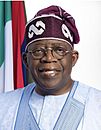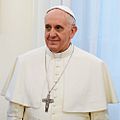Head of state facts for kids
- Emmanuel Macron, President of France
- Droupadi Murmu, President of India
- Joe Biden, President of the United States
- Yoon Suk-yeol, President of South Korea
- Charles III, King of the United Kingdom
- Luiz Inácio Lula da Silva, President of Brazil
- Bola Tinubu, President of Nigeria
- Halimah Yacob, President of Singapore
- Vladimir Putin, President of Russia
The head of state of a country is its highest leader. However, the head of state may not have very much real power.
In a modern republic, the head of state is a president, usually elected by the people or by a parliament. In a monarchy, the head of state is the king or queen. Some countries have different systems - for example the head of state of the Vatican City is the Pope.
In a modern monarchy, the head of state usually has little real power. Instead, the most powerful person is the head of government. This is usually the leader of the political party that wins the most seats in an election. In these cases the king is considered to be the leader of the country, but must always take the decisions that the head of government advises them to make. The king or queen carries out national ceremonies. The United Kingdom works like this, with the Prime Minister heading the government.
A president may be the most powerful person in the country. This is true in the United States. However, sometimes there is a head of government, as well as a president. The president then acts very much like a king or queen, leaving the real decisions to the head of government. The Republic of Ireland works like this.
In older times, and in some modern countries, the head of state has absolute power, this called an absolute monarchy.
Images for kids
-
Grassalkovich Palace in Bratislava is the seat of the President of Slovakia.
-
Elizabeth II is the reigning monarch and head of state of the United Kingdom and 14 other countries
-
Charles de Gaulle, President and head of state of the French Fifth Republic (1959–1969)
-
George Washington, the first president of the United States, set the precedent for an executive head of state in republican systems of government
-
George V, Emperor of India, and Empress Mary at the Delhi Durbar, 1911.
-
Tekiso Hati, ambassador of the Kingdom of Lesotho, presenting his credentials to Russian president Vladimir Putin
-
Daniel B. Shapiro, U.S. ambassador to Israel, presents his credentials to Israeli president Shimon Peres on 3 August 2011
-
A 1992 Letter of Credence, written in French, for the Czechoslovakian Ambassador to Lithuania, signed by the President of Czechoslovakia and addressed to his Lithuanian counterpart
-
Albert II, King of the Belgians inspecting troops on Belgium's national day in 2011
-
Nicolas Sarkozy, President of France and General Jean-Louis Georgelin, Chief of the Defence Staff, reviewing troops during the 2008 Bastille Day military parade on the Champs-Élysées in Paris
-
Francis, from March 2013 the sovereign of the Vatican City State, an ex officio role of the Pope
-
Abdulmecid II is the 150th and last Caliph of Islam from Ottoman dynasty
-
Four generations of Danish kings in 1903: King Christian IX (left), Christian (X) (back), Frederick (VIII) (right), and Frederick (IX) (front)
-
The National Monument to Emperor Wilhelm I in Berlin, Germany, dedicated 1897, nearly 10 years after his death. The monument was destroyed by the communist government in 1950.
-
Frontispiece of Thomas Hobbes' Leviathan (1651)
See also
 In Spanish: Jefe de Estado para niños
In Spanish: Jefe de Estado para niños






























